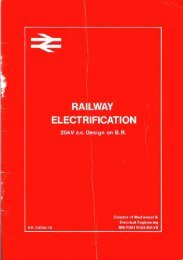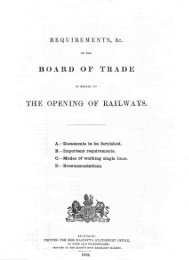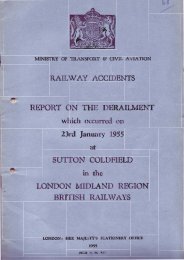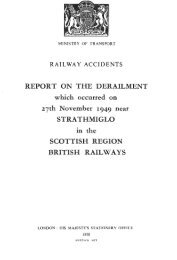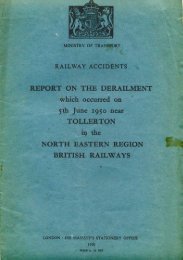R A I LT R AC K - The Railways Archive
R A I LT R AC K - The Railways Archive
R A I LT R AC K - The Railways Archive
Create successful ePaper yourself
Turn your PDF publications into a flip-book with our unique Google optimized e-Paper software.
2<br />
156<br />
East Coast Main Line: London to Edinburgh continued<br />
Our ECML upgrade scheme continued<br />
Edinburgh Waverley We will continue to invest in improved passenger facilities at Edinburgh Waverley. Our growth predictions indicate that<br />
significant alterations will be required to create additional capacity.<br />
Freight priority route <strong>The</strong> freight operators on the ECML are forecasting significant growth. Many of the proposals described above will lead to a<br />
railway that caters for the growth of high-speed train services alongside existing freight services. A fundamental part of our<br />
philosophy is to upgrade (and in one case, reopen) parallel lines as well as upgrading two- and three-track sections to four<br />
tracks to take slower-moving traffic off the main line. This will release capacity for high-speed services to the benefit of<br />
passenger and other high-speed services.<br />
<strong>The</strong> freight priority route from London to Newcastle is proposed as below:<br />
• London–Peterborough: via Hertford Loop, plus restoration of additional tracks between Huntingdon and Peterborough.<br />
• Peterborough–Doncaster: the parallel route via Lincoln will be upgraded. <strong>The</strong> flyover at Peterborough and remodelling of<br />
the layout at Doncaster is integral to this section.<br />
• Doncaster–York: reinstatement of a chord line at South Elmsall and upgrading of the Moorthorpe–Church Fenton Line and a<br />
new loop at Skellow.<br />
• Northallerton–Newcastle: upgrading the Northallerton–Eaglescliffe–Stockton–Ferryhill route, reinstatement of the Leamside<br />
(Ferryhill–Gateshead) Line and Norwood Curve at Bensham.<br />
<strong>The</strong>se major schemes overcome the capacity barriers and delays to freight services imposed by the various double-track<br />
sections on the ECML. Coupled with existing and proposed four-track sections of the main line, they are equivalent to four<br />
tracking the ECML from Newcastle to the London area giving freight operators better transit times and the opportunity to<br />
increase the numbers of trains. A study into the route’s capability to take larger gauge freight traffic has also been undertaken,<br />
and we are consulting with freight operators to identify realistic needs. <strong>The</strong> freight priority routes may lead to new and exciting<br />
opportunities to develop local services and new stations. An example of such would be a new passenger service via the<br />
Leamside Line from Middlesbrough to Newcastle via new stations in County Durham and at Washington. Additional funding<br />
and support is actively being sought from local authorities and PTEs to facilitate such a scheme.<br />
In addition, we are currently assessing the options to provide appropriate capacity for both existing and projected freight train<br />
volumes north from Newcastle to central Scotland.<br />
Tilting train operation To successfully operate tilting trains and improve journey times by moving at faster speeds, we will need to close or divert<br />
many occupational and footpath level crossings, create linespeed improvements, enlarge clearances, provide additional areas for<br />
trackside safety, enhance signalling and make track modifications.<br />
Power upgrades Existing overhead-line power supplies are already stretched at a number of locations and further upgrades to power supplies<br />
are required to increase capacity, reliability and improve journey times. Power supply upgrades are an essential part of the<br />
capacity upgrade as is the development of the railway layout. Particular power-supply bottlenecks exist in the Home Counties,<br />
Lincolnshire, Northumberland and Scotland.<br />
Thameslink 2000 In addition to the above, the Thameslink 2000 project is planned to be constructed between 2002 and 2006, allowing a<br />
completely new high-intensity timetable between Peterborough, Cambridge and stations south of London including East<br />
Croydon and Gatwick Airport. As well as meeting the current needs for commuter travel to central London, the new services<br />
will create many new journey opportunities and increase the demand for travel.<br />
Parkway stations A number of operators, in particular Great North Eastern Railway (GNER), have identified key regions where access to rail<br />
services could be improved through building new ‘parkway‘ stations. <strong>The</strong> introduction of such stations would also help alleviate<br />
local road congestion in the centres of busy urban areas.<br />
<strong>The</strong> feasibility of parkways to the east of Edinburgh, adjacent to the M18 in South Yorkshire, and North of London (M25) are<br />
being considered in conjunction with train operators, local authorities and passenger groups.<br />
Railtrack is considering other possible station sites.



